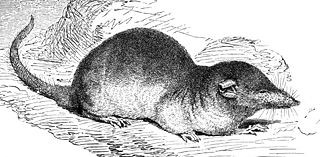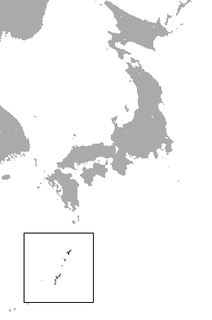
The white-toothed shrews or Crocidurinae are one of three subfamilies of the shrew family Soricidae.

The lesser white-toothed shrew is a tiny shrew with a widespread distribution in Africa, Asia and Europe. Its preferred habitat is scrub and gardens and it feeds on insects, arachnids, worms, gastropods, newts and small rodents, though its diet usually varies according to the biotope where it lives. The closely related Asian lesser white-toothed shrew was once included in this species, but is now considered to be a separate species.

The São Tomé shrew is a white-toothed shrew about 3.0 in (7.6 cm) long found only on São Tomé Island, São Tomé and Príncipe. It is listed as a critically endangered species due to habitat loss and a restricted range. It was discovered in 1886. The population continues to decrease, making these animals rare. It is found only on São Tomé Island, a small island that is actually a shield volcano that rises out of the Atlantic Ocean.

The genus Crocidura is one of nine genera of the shrew subfamily Crocidurinae. Members of the genus are commonly called white-toothed shrews or musk shrews, although both also apply to all of the species in the subfamily. With over 180 species, Crocidura contains the most species of any mammal genus. The name Crocidura means "woolly tail", because the tail of Crocidura species are covered in short hairs interspersed with longer ones.

The Hun shrew is a species of mammal in the family Soricidae. It is found in Cameroon, Central African Republic, Mali, Democratic Republic of the Congo, and Nigeria. Its natural habitats are tropical or subtropical moist lowland or montane forest, and heavily degraded former forest.

Bates's shrew is a species of mammal in the family Soricidae. It is found in Cameroon, Republic of the Congo, Equatorial Guinea, and Gabon. Its natural habitat is subtropical or tropical moist lowland forests. This large black shrew was first described by the British zoologist Guy Dollman in 1915, the type locality being the vicinity of the Como River in Gabon. The exact definition of this species is unclear; it is often included in Fraser's musk shrew, or reported as Wimmer's shrew. Its karyotype is 2n=50, FN-76, which is identical to the Nigerian shrew, and the species complex is in need of a thorough revision.

Dent's shrew is a species of mammal in the family Soricidae. It is found in Cameroon, Central African Republic, Republic of the Congo, Democratic Republic of the Congo, Equatorial Guinea, Gabon, Guinea, Liberia, Nigeria, Sierra Leone, and Uganda. Its natural habitats are subtropical or tropical moist lowland forest and moist savanna.

The greater red musk shrew is a species of mammal in the family Soricidae. It is found in Lesotho, Mozambique, South Africa, and Eswatini. Its natural habitats are moist savanna, temperate grassland, and rural gardens. Like most shrew species, C. flavenscens is nocturnal. The greater red musk shrew is considered to be asocial and territorial, with males using scent marking to establish their territory. Males appear to be more aggressive than females, and their aggression increases with greater population density.

The Sulawesi shrew is a species of mammal in the family Soricidae. It is endemic to the central and northern provinces of Sulawesi in Indonesia. It is a fairly common species and the International Union for Conservation of Nature has assessed its conservation status as being of "least concern".

The swamp musk shrew, or musk shrew, is a species of mammal in the family Soricidae. It occurs in Angola, Botswana, Democratic Republic of the Congo, Mozambique, Namibia, South Africa, Eswatini, Zambia and Zimbabwe. Its natural habitat is swamps, and it is a common species in suitable habitats, with the International Union for Conservation of Nature listing it as being of "least concern".

The African black shrew is a species of shrew. It is native to Africa, where it is widespread. Other common names include tenebrous shrew. This shrew can be found in several types of lower-elevation moist tropical forest habitat.

The pale gray shrew is a species of mammal in the family Soricidae. It is endemic to Pakistan and is distributed in the Shigar valley and the western edge of Deosai.

Fraser's musk shrew is a species of mammal in the family Soricidae. It is found in Benin, Cameroon, Ivory Coast, Equatorial Guinea, Ghana, Guinea, Liberia, Nigeria, São Tomé and Príncipe, Sierra Leone, and Togo. Its natural habitat is subtropical or tropical moist lowland forests. This large black shrew was first described by the British zoologist Louis Fraser in 1843. Its exact definition is unclear; the karyotype comes from Ivory Coast but not from Equatorial Guinea, which is given as the type locality.

The turbo shrew is a species of mammal in the family Soricidae. It is found in Angola, Burundi, Cameroon, Central African Republic, Republic of the Congo, Democratic Republic of the Congo, Equatorial Guinea, Gabon, Kenya, Malawi, Rwanda, South Sudan, Tanzania, Uganda, and Zambia. Its natural habitats are subtropical or tropical moist lowland and montane forests.

Whitaker's shrew is a species of mammal in the family Soricidae. It is found in Western Sahara, Algeria, Morocco, Tunisia. Its natural habitats are subtropical or tropical dry shrubland, rocky and sandy coasts. It is a fairly common species and the International Union for Conservation of Nature has rated its conservation status as being of "least concern".

The lesser Ryukyu shrew, or Watase's shrew is a common species of shrews that is endemic to Japan. It is often found living in bushes and grasslands along the river banks and in shrubs of lower elevations.

The Indochinese shrew is a species of white-toothed shrew native to Southeast Asia. It was first identified in 1922 by Herbert C. Robinson and C. Boden Kloss. The species is often taxonomized as a subspecies Horsfield's shrew, but bears a different range, occurring in Myanmar, Vietnam, and the Yunnan province of China. C. indochinensis is on the smaller end of shrews, with dark brownish gray fur and a long, slender tail.

















